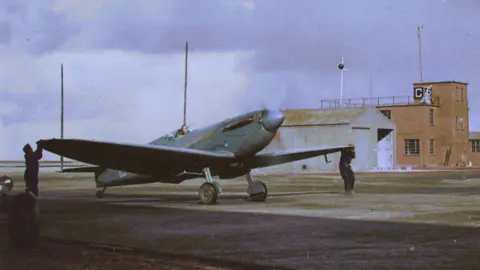Museum display marks efforts of 'spies in the sky'
 Anthony Hoskins/ Spitfire AA810 Project
Anthony Hoskins/ Spitfire AA810 ProjectThe fuselage of a Spitfire shot down during World War Two has gone on display at a museum to mark the efforts of Kent pilots who served as "spies in the sky".
The Spitfire AA810 was part of the RAF photo reconnaissance unit (PRU), which played a crucial role in obtaining intelligence for Allied commanders to plan military operations.
Shot down in 1942 and later pulled from a peat bog in Norway by a group of volunteers, the Spitfire AA810 was later rebuilt on the Isle of Wight.
Its fuselage is now on display at the Spitfire and Hurricane Museum in Manston, Kent, as part of a bid to raise awareness of the Spitfire reconnaissance team.
 Anthony Hoskins / Spitfire AA810 Project
Anthony Hoskins / Spitfire AA810 ProjectMuseum manager Robert Westbrook said that while people normally associate the Spitfire's role as a "fighter plane during the Battle of Britain" it actually flew unarmed.
He said it could only escape enemy fire due to its "speed and manoeuvrability".
The museum is working with the Spitfire AA810 project team to highlight the stories of the pilots from Kent who flew these essential missions.
Spitfire PR.IV AA810 on display was piloted by a young Scottish apprentice engineer, Flt Lt Alastair "Sandy" Gunn, who was attempting to photograph a German battle ship.
Gunn bailed out but was captured, interrogated, imprisoned and later executed after the Stalag Luft III "Great Escape".
The escape attempt was cemented in popular culture in the 1963 film of the same name, which starred Steve McQueen, Richard Attenborough and James Garner.
 Anthony Hoskins / Spitfire AA810 Project
Anthony Hoskins / Spitfire AA810 ProjectDescendants of Kent pilots who were part of the PRU have told the BBC their stories.
Jane Wilson, from Deal, said her father joined the RAF when he was 21 and the family were "very proud" of his contributions to the war.
She said: "What he did was very brave but he was modest about it."
She felt he should be "recognised and appreciated" for his role during the conflict.
"Even though each generation has changed - it's important to remember what happened in the past," she said.
 Anthony Hoskins/ Spitfire AA810 Project
Anthony Hoskins/ Spitfire AA810 ProjectGuy Leaning, whose father Sqn Ldr Anthony Leaning also served as a "spy in the sky", said the PRU's efforts in the conflict were largely overlooked.
He said the intelligence they provided helped the Allies win the war.
He added: "I think the PRU isn't well known because they carried out secret operations but I am pleased my father, his friends and my two godfathers are recognised for their efforts."
He said his father never talked about those who did not return.
"He lost a friend but they just carried on fighting," he said.
The PRU was formed in September 1939 and during World War Two, the team captured more than 26m images of enemy operations and installations.
Anthony Hoskins, from West Sussex, is the director of the Spitfire AA810 project.
In 2018, Mr Hoskins and his team recovered Gunn's aircraft from a peat bog in Norway and rebuilt it on the Isle of Wight.
He said it was important to tell the stories of the brave pilots, adding: "More than 1,700 PRU pilots and navigators came from 23 different nationalities."
According to the Spitfire AA810 project, 39 of the pilots were from Kent; 17 were killed during the operations while four were either captured or evaded capture.
Follow BBC Kent on Facebook, on X, and on Instagram. Send your story ideas to [email protected] or WhatsApp us on 08081 002250.
